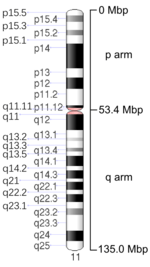Chromosome 11 (human)
| Chromosome 11 (human) | |
|---|---|
 Pair of human chromosome 11 (after G-banding). One is from mother, one is from father. | |
 Chromosome 11 pair in human male karyogram. | |
| Features | |
| Length (bp) | 135,086,622 bp |
| Number of genes | 2,364 |
| Type | Autosome |
| Centromere position | Submetacentric[1] |
| Identifiers | |
| RefSeq | NC_000011 |
| GenBank | CM000673 |

Chromosome 11 is one of the 23 pairs of chromosomes in humans. Humans normally have two copies of this chromosome. Chromosome 11 spans about 135 million base pairs (the building material of DNA) and represents between 4 and 4.5 percent of the total DNA in cells. It is one of the most gene- and disease-rich chromosomes in the human genome.
Identifying genes on each chromosome is an active area of genetic research. Because researchers use different approaches to predict the number of genes on each chromosome, the estimated number of genes varies. Chromosome 11 likely contains between 1,300 and 1,700 genes.
A recent study [2] shows that 11.6 genes per megabase, including 1,524 protein-coding genes and 765 pseudogenes can be found on chromosome 11.
More than 40% of the 856 olfactory receptor genes in the human genome are located in 28 single- and multi-gene clusters along this chromosome.
Genes
The following are some of the genes located on chromosome 11:
- ACAT1: acetyl-Coenzyme A acetyltransferase 1 (acetoacetyl Coenzyme A thiolase)
- ACRV1: encoding protein Acrosomal protein SP-10
- AMPD3: encoding enzyme AMP deaminase 3
- APLNR: Apelin receptor (APJ receptor)
- API5: encoding protein Apoptosis inhibitor 5
- APOA4: apolipoprotein A-IV
- ASRGL1: encoding enzyme L-asparaginase
- ATM: ataxia telangiectasia mutated (includes complementation groups A, C and D)
- B3GNT1: encoding enzyme N-acetyllactosaminide beta-1,3-N-acetylglucosaminyltransferase
- BDNF: secretes BDNF, a member of the Neurotrophin family of proteins
- C11orf1: encoding protein
- C11orf16: encoding protein Uncharacterized protein C11orf16
- C11orf49: encoding protein UPF0705 protein C11orf49
- C11orf54: encoding protein Ester hydrolase C11orf54
- C11orf86: encoding protein Uncharacterized protein C11orf86
- C1QTNF5: encoding protein C1q and tumor necrosis factor related protein 5
- CCL9: Chemokine (C-C motif) ligand 9
- CD81
- CPT1A: carnitine palmitoyltransferase 1A (liver)
- DHCR7: 7-dehydrocholesterol reductase
- HBB: hemoglobin, beta
- HMBS: hydroxymethylbilane VIIA
- INS: insulin gene [3]
- MMP7: Matrix metalloproteinases (MMP family)
- MEN1: Multiple endocrine neoplasia type 1
- NRGN
- PAX6
- PTS: 6-pyruvoyltetrahydropterin synthase
- RPL27A: encoding protein 60S ribosomal protein L27a
- RPL36A: encoding protein 60S ribosomal protein L36a
- SAA1: serum amyloid A1
- SBF2: SET binding factor 2
- SMPD1: sphingomyelin phosphodiesterase 1, acid lysosomal (acid sphingomyelinase)
- TECTA: tectorin alpha (nonsyndromic deafness)
- TH: tyrosine hydroxylase
- USH1C: Usher syndrome 1C (autosomal recessive, severe)
- WT1: Wilms tumor protein
- RAG1/RAG2: recombination activating genes
Diseases and disorders
| Wikinews has related news: Large study provides new insights in autism's genetic code |
The following diseases and disorders are some of those related to genes on chromosome 11:
- autism (neurexin 1) [4]
- annidraedea
- acute intermittent porphyria
- albinism
- ataxia-telangiectasia
- Beckwith-Wiedemann syndrome
- Best's disease
- beta-ketothiolase deficiency
- beta thalassemia
- bladder cancer
- breast cancer
- carnitine palmitoyltransferase I deficiency
- Charcot-Marie-Tooth disease
- Charcot-Marie-Tooth disease, type 4
- Cystic Fibrosis
- Depression
- Denys-Drash syndrome
- familial Mediterranean fever
- Hereditary angioedema OMIM: 106100
- Jacobsen syndrome
- Jervell and Lange-Nielsen syndrome
- Mantle cell lymphoma (t11;14)
- Meckel syndrome
- methemoglobinemia, beta-globin type
- Mixed Lineage Leukemia
- multiple endocrine neoplasia type 1
- Hereditary Multiple Exostoses
- Niemann-Pick disease
- nonsyndromic deafness
- nonsyndromic deafness, autosomal dominant
- nonsyndromic deafness, autosomal recessive
- porphyria
- Potocki-Shaffer Syndrome
- Romano-Ward syndrome
- Sickle cell anemia[5]
- Smith-Lemli-Opitz syndrome
- tetrahydrobiopterin deficiency
- Usher syndrome
- Usher syndrome type I
- WAGR syndrome
- Wilms' tumor
References
- ↑ "Table 2.3: Human chromosome groups". Human Molecular Genetics (2nd ed.). Garland Science. 1999.
- ↑ Taylor TD, Noguchi H, Totoki Y, Toyoda A, Kuroki Y, Dewar K, Lloyd C, Itoh T, Takeda T, Kim DW, She X, Barlow KF, Bloom T, Bruford E, Chang JL, Cuomo CA, Eichler E, FitzGerald MG, Jaffe DB, LaButti K, Nicol R, Park HS, Seaman C, Sougnez C, Yang X, Zimmer AR, Zody MC, Birren BW, Nusbaum C, Fujiyama A, Hattori M, Rogers J, Lander ES, Sakaki Y (2006). "Human chromosome 11 DNA sequence and analysis including novel gene identification". Nature. 440 (7083): 497–500. doi:10.1038/nature04632. PMID 16554811.
- ↑ INS - insulin - Genetics Home Reference
- ↑ "Autism gene breakthrough hailed". Health. BBC NEWS. 2007-02-19. Retrieved 2010-01-02.
- ↑ Human Genome Project Information Site Has Been Updated
- Gilbert F (2000). "Disease genes and chromosomes: disease maps of the human genome". Genet Test. 4 (4): 409–26. doi:10.1089/109065700750065180. PMID 11216668.
| Wikimedia Commons has media related to Human chromosome 11. |